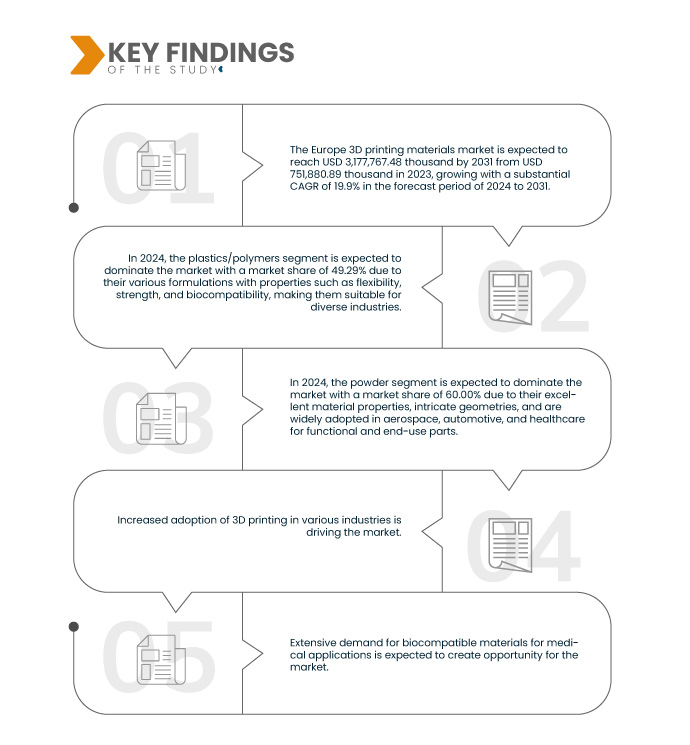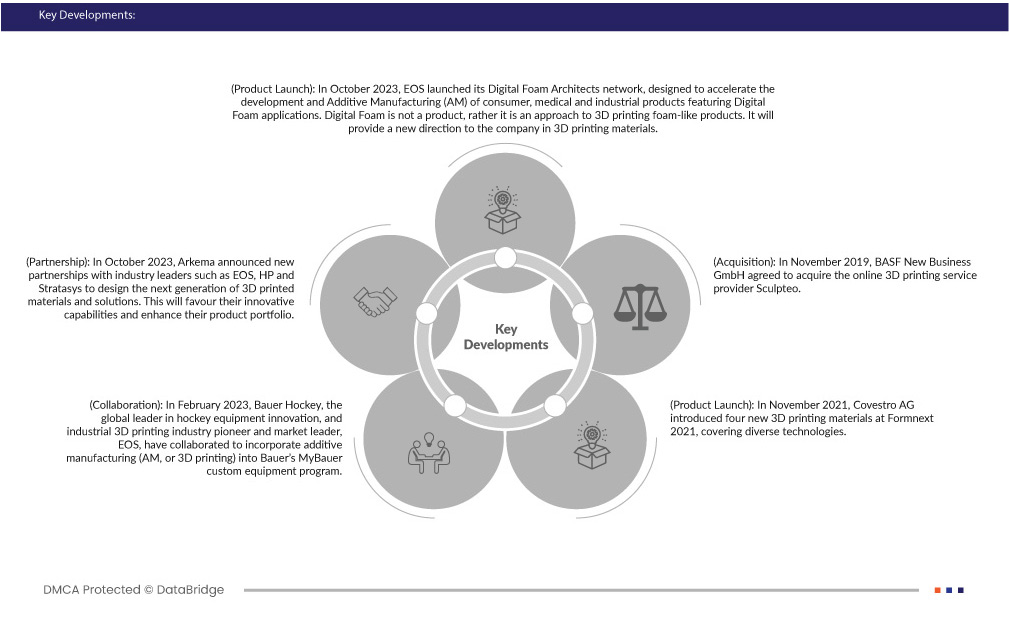There is a corresponding surge in demand for materials that can meet the diverse requirements of this innovative manufacturing process as industries embrace the revolutionary capabilities of 3D printing. The versatility of 3D printing, also known as additive manufacturing, spans industries such as aerospace, healthcare, automotive, and consumer goods, where the technology is employed for rapid prototyping, customized production, and intricate design fabrication. The factor contributing to the demand for 3D printing materials is the technology's ability to produce complex and highly customized components. Traditional manufacturing methods is not much efficient and fast as industries seek more complicated and precisely designed parts. 3D printing addresses this gap by allowing the creation of geometrically complex structures with enhanced efficiency. This necessitates a broad spectrum of materials tailored to different applications—ranging from plastics and metals to ceramics and composites. The demand for diverse materials that can meet specific industry needs is thus propelled by the versatility of 3D printing technology.
Access Full Report @ https://www.databridgemarketresearch.com/reports/europe-3d-printing-materials-market
Data Bridge Market Research analyzes that the Europe 3D Printing Materials Market is expected to reach USD 3,177,767.48 thousand by 2031, from USD 751,880.89 thousand in 2023, growing with a substantial CAGR of 19.9% in the forecast period of 2024 to 2031.
Key Findings of the Study
Expanding Accessibility and Affordability of 3D Printing Technologies
This surge in the adoption of 3D printing is propelling the demand for a range of materials suitable for various applications. Materials ranging from polymers and metals to ceramics and composites are now integral to 3D printing applications and technologies. The increased accessibility of these technologies has led to a diverse user base, each with unique material requirements. The accessibility and affordability of 3D printing have also increased innovation in material development. Researchers and manufacturers are investing in creating specialized materials that accommodate the evolving needs of diverse applications. This has led to the emergence of advanced materials with enhanced properties, such as improved strength, flexibility, and heat resistance. This has expanded the addressable market for 3D printing materials, driving higher volumes of material consumption.
Report Scope and Market Segmentation
|
Report Metric
|
Details
|
|
Forecast Period
|
2024 to 2031
|
|
Base Year
|
2023
|
|
Historic Years
|
2022 (Customizable to 2016-2021)
|
|
Quantitative Units
|
Revenue in USD Thousand
|
|
Segments Covered
|
Type (Plastics/Polymers, Metal, Ceramic, and Others), Form (Powder, Filament, and Liquid), Technology (Fused Deposition Modeling (FDM), Selective Laser Sintering (SLS), Stereolithography (SLA), Direct Metal Laser Sintering (DMLS), Big Area Additive Manufacturing (BAAM), Wire Arc Additive Manufacturing (WAAM), ColorJet, and Others), End-Use (Industrial Manufacturing, Automotive, Aerospace & Defense, Healthcare, Consumer Goods, Electronics, Education, Construction, and Others)
|
|
Countries Covered
|
Germany, Italy, U.K., France, Spain, Turkey, Russia, Switzerland, Belgium, Netherlands, Luxembourg, and Rest of Europe
|
|
Market Players Covered
|
Formlabs (U.S.), EOS (Germany), ENVISIONTEC US LLC (U.S.), American Elements (U.S.), Höganäs AB (Sweden), UltiMaker (Netherlands), Carbon, Inc. (U.S.), KRAIBURG TPE GmbH & Co. KG (Germany), Covestro AG (Germany), Markforged, Inc. (U.S.), Stratasys (U.S.), ExOne (U.S.), Arkema (France), 3D Systems, Inc. (Japan), Evonik Industries AG (Germany), Materialise (Belgium), BASF SE (Germany), Solvay (Belgium), and Sandvik AB (Sweden), among others
|
|
Data Points Covered in the Report
|
In addition to the insights on market scenarios such as market value, growth rate, segmentation, geographical coverage, and major players, the market reports curated by the Data Bridge Market Research also include in-depth expert analysis, geographically represented company-wise production and capacity, network layouts of distributors and partners, detailed and updated price trend analysis and deficit analysis of supply chain and demand
|
Segment Analysis
The Europe 3D printing materials market is segmented into four notable segments based on type, form, technology, and end-use.
- On the basis of type, the Europe 3D printing materials market is segmented into plastics/polymers, metal, ceramic, and others
In 2024, the plastics/polymers segment is expected to dominate the Europe 3D Printing Materials Market
In 2024, the plastics/polymers segment is expected to dominate the market with a market share of 49.29% due to its various formulations with properties such as flexibility, strength, and biocompatibility, making them suitable for diverse industries.
- On the basis of form, the Europe 3D printing materials market is segmented into powder, filament, and liquid
In 2024, the powder segment is expected to dominate the Europe 3D Printing Materials Market
In 2024, the powder segment is expected to dominate the market with a market share of 60.00% as powder-based processes offer excellent material properties, intricate geometries, and are widely adopted in aerospace, automotive, and healthcare for functional and end-use parts.
- On the basis of technology, the Europe 3D printing materials market is segmented into Fused Deposition Modeling (FDM), Selective Laser Sintering (SLS), Stereolithography (SLA), Direct Metal Laser Sintering (DMLS), Big Area Additive Manufacturing (BAAM), Wire Arc Additive Manufacturing (WAAM), colorjet, and others. In 2024, the Fused Deposition Modeling (FDM) segment is expected to dominate the market with a market share of 35.95%
- On the basis of end-use, the Europe 3D printing materials market is segmented into industrial manufacturing, automotive, aerospace & defense, healthcare, consumer goods, electronics, education, construction, and others. In 2024, the industrial manufacturing segment is expected to dominate the market with a market share of 21.13%
Major Players
Data Bridge Market Research analyzes Stratasys (U.S.), EOS (Germany), 3D Systems, Inc. (Japan), BASF SE (Germany), and Materialise (Belgium) as the major players in the Europe 3D printing materials market.
Market Developments
- In October 2023, EOS launched its Digital Foam Architects network, designed to accelerate the development and additive manufacturing (AM) of consumer, medical and industrial products featuring Digital Foam applications. Digital Foam is not a product, rather it is an approach to 3D printing foam-like products. It will provide a new direction to the company in 3D printing materials
- In October 2023, Arkema announced new partnerships with industry leaders such as EOS, HP and Stratasys to design the next generation of 3D printed materials and solutions. This will favour their innovative capabilities and enhance their product portfolio
- In February 2023, Bauer Hockey, the Europe leader in hockey equipment innovation, and industrial 3D printing industry pioneer and market leader, EOS, have collaborated to incorporate additive manufacturing (AM, or 3D printing) into Bauer’s MyBauer custom equipment program. EOS and its patented Digital Foam approach to printing polymers gave Bauer a distinct advantage. It will strengthen the market presence for EOS in the Europe 3D Printing Materials market
- In November 2021, Covestro AG introduced four new 3D printing materials at Formnext 2021, covering diverse technologies. Among them is Addigy FPC SOL1 HT, a soluble support material for FDM printing of high-temperature materials, offering easy removal and sustainability. Arnitel AM3001 (P) for SLS, a soft material with high energy return, achieved successful 3D printing with compliance with Toy Safety standards. Covestro also launched SLS and HSS versions of its TPU powder, Addigy PPU 86AW6, known for rebound, easy post-processing, and high reuse rate. These additions expand Covestro's polymer choices for 3D printing, following its acquisition of DSM's additive manufacturing business earlier this year
- In November 2019, BASF New Business GmbH agreed to acquire the online 3D printing service provider Sculpteo. The agreement was signed on November 14, 2019 and was expected to become effective in the next few weeks pending regulatory approval by the relevant authorities. The acquisition of the French 3D printing specialist based in Paris and San Francisco had enabled BASF 3D Printing Solutions GmbH, a wholly-owned subsidiary of BASF New Business GmbH, to market and establish new industrial 3D printing materials more quickly which strengthened the production capacity of BASF
Regional Analysis
Geographically, the countries covered in the Europe 3D printing materials market are Germany, Italy, U.K., France, Spain, Turkey, Russia, Switzerland, Belgium, Netherlands, Luxembourg, and rest of Europe.
As per Data Bridge Market Research analysis:
Germany is estimated to be the dominant and fastest-growing county in the Europe 3D Printing Materials Market
Germany is estimated to be the dominant and fastest-growing county in the market due to the expanding accessibility and affordability of 3D printing technologies in the country.
For more detailed information about the Europe 3D Printing Materials Market report, click here – https://www.databridgemarketresearch.com/reports/europe-3d-printing-materials-market












